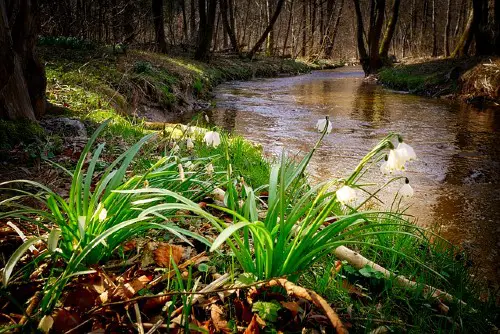What is Seepage? – Meaning, Factors, and Effects (explained)
Compiled by Stanley Udegbunam || Nov 18, 2020
AFRILCATE
WHAT IS SEEPAGE?
In hydrology, seepage otherwise known as seepage flow refers to the slow movement of fluid through small openings or cracks in the surface of unsaturated soil.
The fluid fills the pores in the unsaturated bottom layer and moves into the deeper layers as a result of the effect of gravity.
Seepage is common around hydraulic structures.
FACTORS AFFECTING SEEPAGE FLOW
Seepage flow depends on several factors that determine the level of fluid movement.
These factors include:
- Soil porosity
- Permeability
- Infiltration capacity
- Precipitation Intensity
- Hydraulic Conductivity
- Hydrostatic Pressure
- Weak interlayers of geologic formations

-
Soil porosity
This refers to the amount of empty space in rock or soil aggregate.
These empty spaces are called pores and since they are void, such materials have water holding capacity.
Although the aim is not to store the water in the subsoil surface but to percolate it downwards.
Porosity still remains a major factor for seepage flow because water can’t seep through non-porous or compacted soil.
-
Permeability
This is a measure of the ease with which a fluid can move through porous rock.
A permeable substance is one whose pore spaces are connected to each other making it easy for fluid to flow through.
Permeability can vary over a wide range, depending on soil structure and composition.
Water seepage in sandstone, fractured igneous, and metamorphic rocks are high due to their high permeability.
-
Infiltration Capacity
This is the maximum amount of rainwater that can enter a soil in a given time.
Water will seep continuously in soil with high infiltration capacity.
-
Precipitation Intensity
The higher the magnitude of rainfall or snowmelt, the more the seepage rate.
-
Hydraulic Conductivity
This is fluid conduction through pore spaces and fractures.
In contrast to permeability, hydraulic conductivity considers both the porous medium and the flowing fluid.
Therefore it is affected by the density and viscosity of the flowing fluid.
The hydraulic conductivity of a strata influences seepage flow.
-
Hydrostatic Pressure
As groundwater level rises, water in the soil creates hydrostatic pressure against your home’s foundation.
This pressure forces water into your home through the tiniest cracks in your basement’s floor and walls.
-
Weak interlayers of geologic formations
Weak interlayers indicate loose structure, weak intergranular bonding, and low strength.
The presence of a weak interlayer serves as channels of water flow, resulting in deformations and cracks at different locations in underground bodies.
Underground water seeps through these openings into beds of lakes, wetlands and stream channels.
The presence of weak interlayers and groundwater are common adverse geological conditions in tunnels.

EFFECTS OF SEEPAGE FLOW
- Seepage flow from weak interlayers in underground structures like dams and tunnels indicates to a large extent its level of structural instability and a major concern in geoengineering.
- Many failures of underground openings have been reported to be closely related to a weak interlayer nearby.
- Incident flow from wells or drainage facilities can also be described by the physical principles of seepage flow.
- In engineering, flow processes such as those that occur in seepage flows are used in filter technology. In this case, fluid flows through a pore space for the purposes of cleaning or separation of media.
- Seepage in an upward direction reduces the effective stress within the soil.
- Underground water seepage is required in hydrogeology for the continuous recharge of aquifers.
-
Unfortunately, water seepage in buildings can lead to serious structural issues such as foundation sinking or settlement and ultimately, its collapse altogether.
-
If your basement has underground windows, then chances are you’re susceptible to seepage. Clogging, cracking, and improper installation may allow water from the soil to seep into the well, preventing it from draining correctly.

WHAT IS THE ROLE OF SEEPAGE IN THE WATER CYCLE?
Water seepage occurs at the surface of the soil through small cracks and openings.
After seepage flow, the water percolates downwards through different geological formations and this is how aquifers are recharged.
While seepage can occur at the surface level, percolation occurs at a much deeper depth.
You must be wondering… What then is the difference between seepage and infiltration right?
Infiltration is the downward movement of water into the soil. It also occurs on the surface like seepage.
But seepage is not restricted to just a downward difference as water can also seep in the horizontal direction.
It’s the process by which water leaks through a porous substance and it’s a slower process.
Seepage is influenced by pressure difference so it can flow in any direction.
Underground water also seeps through cracks in aquifers and rocks into river beds or streams.
At this point, surface evaporation can occur which will leads to the saturation of the cloud and further lead to the condensation of precipitates, the cycle continues.
Therefore, seepage is part of the water cycle.
How to fix water seepage in home buildings?
In almost all cases, you shouldn’t perform repairs on leaks yourself.
These problems are likely too big for you to tackle alone.
Contact your local professionals; they can help you avoid costly work that results from rookie mistakes.
This seepage prevention guide by real seal can also be a helpful resource: water seepage prevention

Basement water seepage
DO YOU KNOW?
The study of the distribution, flow, and quality of underground water is called hydrogeology.
DO YOU KNOW?
The study of the distribution, flow, and quality of underground water is called hydrogeology.

